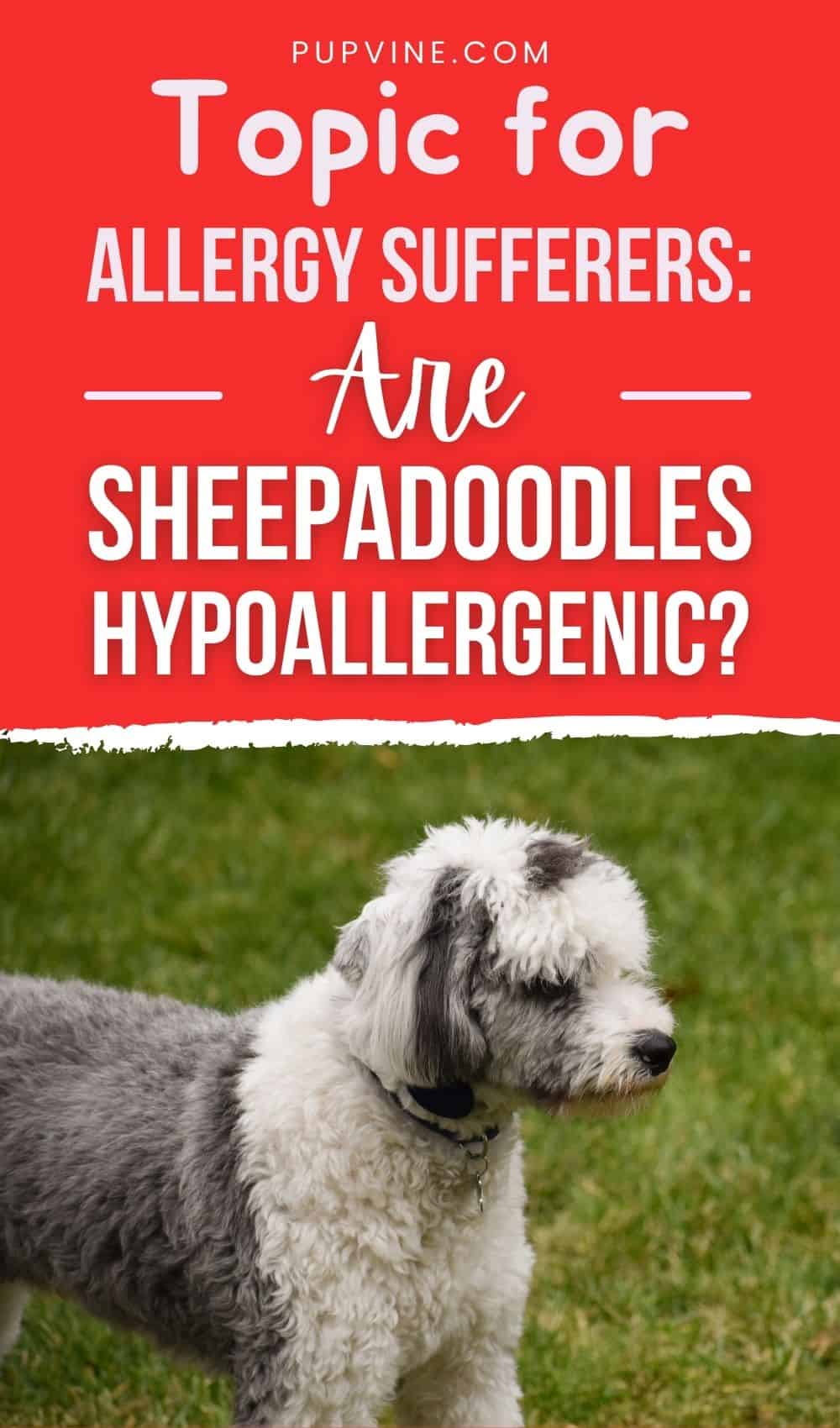If this title caught your eye, it’s fair to say that you’re probably seeking an answer to the question, are Sheepadoodles hypoallergenic?
So we’ll start on a positive note by saying, YES! The Sheepadoodle is generally considered a hypoallergenic breed of dog!
However, as there’s a lot of misunderstanding about what this actually means, we need to dive into this subject and dig out the truth.
Life for allergy sufferers can be challenging at times. They have to be very careful about where they go and what they expose themselves to.
For dog lovers, it’s a real drag. Do they risk bringing a dog into their home and face the annoying and frustrating consequences? Or do they leave it and forever feel that their home is incomplete without that furry companion?
One solution could be to get a hypoallergenic dog!
Sadly, some breeders have misused this word, and it is still widely misunderstood, even by many dog experts.
Join us as we explore the Sheepadoodle world and explain precisely what a hypoallergenic dog is and how it might help allergy sufferers.
We’ll also look at some FAQs and even throw in some advice on reducing the risk of pet allergies ruining your life!
First, we’ll begin with an overview of these fantastic designer dogs before moving on to find out how they might be suitable for people with allergies and seek a more profound answer to the question, are Sheepadoodles hypoallergenic?
What Is A Sheepadoodle Dog?
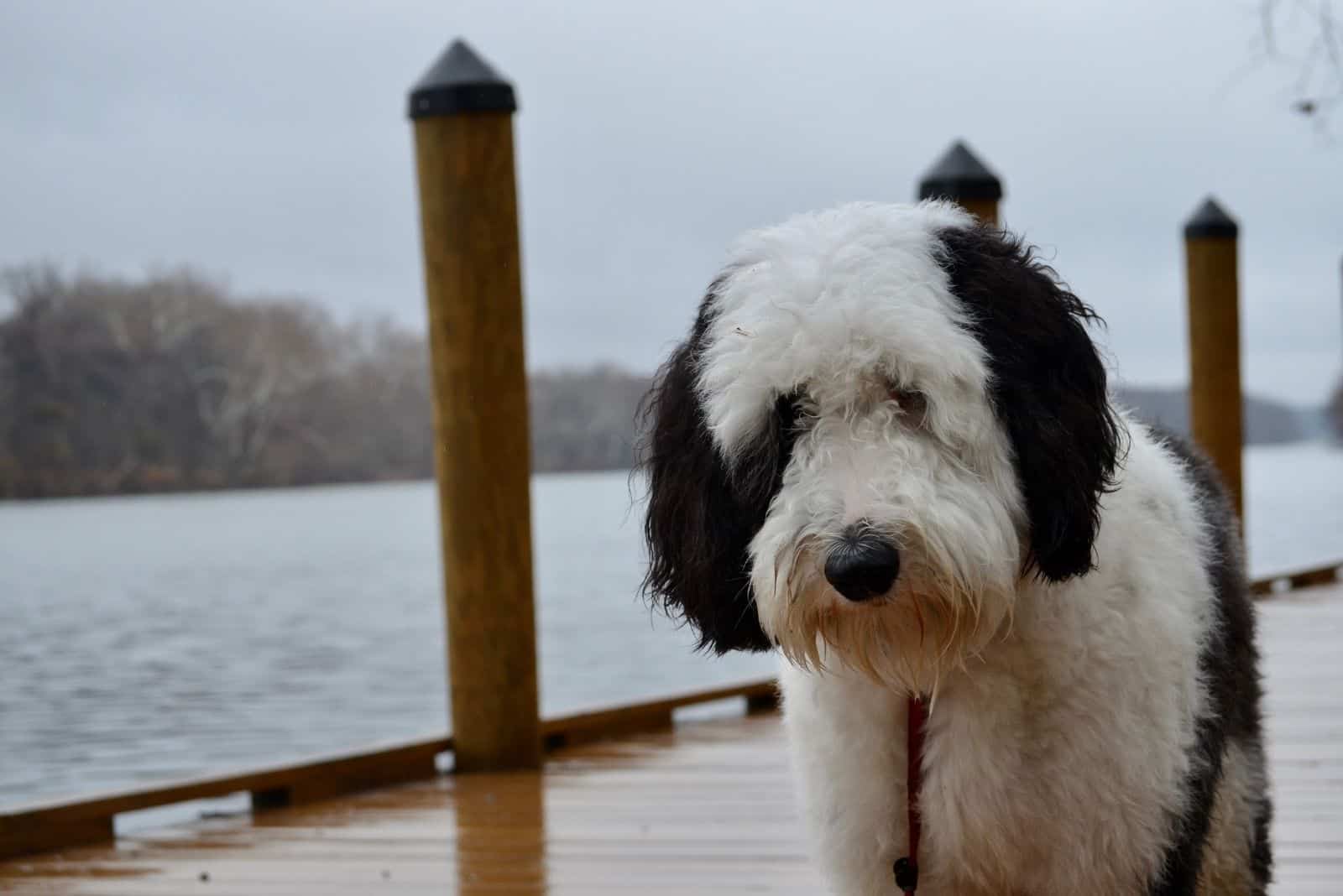
While you may have heard the funny name before, you might not know what a Sheepadoodle is, so let’s put that right:
A Sheepadoodle* is a crossbreed of the purebred Standard Poodle and Old English Sheepdog. They also go by the name Sheepapoo, among others, but Sheepadoodle is the most popularly used by far, so we’ll stick with this one here.
*Not Shepadoodle, which is a German Shepherd Poodle mix!
Sheepadoodle Size
These Doodle dogs come in three sizes depending on the Poodle parent:
• Standard Sheepadoodle 22 to 27 inches 55 to 85 pounds
• Mini/Medium Sheepadoodle 15 to 22 inches 25 to 55 pounds
• Toy Sheepadoodle less than 15 inches 10 to 25 pounds
As you can see, there’s a big difference between the tiniest toy dog and the largest standard one! It’s really up to you which size dog you prefer, but bear in mind that a small dog needs less space, your dog food bills will be lower, and big dogs generally cost a lot more in vet fees.
Also, the smaller the pooch, the less dander will be present, so your Toy or Mini Sheepadoodle will be an even better choice for allergy sufferers.
The small versions are produced by breeding the Old English Sheepdog with Toy Poodles or Miniature Poodles.
Sheepadoodle Temperament
These doodle dogs are like teddy bears, with a personality to match whatever their size. They love to cuddle and are devoted to their owners. There’s nothing they like better than laying on your lap, which can be interesting if you have an 85-pound dog!
These loveable furballs have the Poodle’s sharp intelligence and playful goofiness and the affectionate, sweet-natured willfulness of the Old English Sheepdog parent.
Training them is pretty easy, though you have to stick with it, and first-time dog owners might find it tricky, to begin with. However, with a bit of patience, you’ll get there very soon, as this faithful pup’s desire to please you will overcome its willfulness.
Despite their name, Old English Sheepdogs were mainly used for driving cattle rather than sheep. However, they still have a strong herding instinct that is often passed onto the Sheepadoodle offspring.
These pups have a tendency to round up small animals, pets, children, or anything they can!
It shouldn’t be a problem, and it can be amusing at times, but they may occasionally nip at heels. Proper training and socialization usually help calm their herding dog instinct and keep it under control.
The Poodle is a high-energy pooch and passes this trait onto its Sheepadoodle pups in spades! Although the Old English Sheepdog genes make them more easy-going at times (some puppies will be calmer than others), they are not couch potatoes.
You will need a lot of energy to match the Sheepadoodle!
This designer breed isn’t a good guard dog but could be an excellent watchdog. It will definitely alert you to any intruders but generally won’t stick around if any trouble kicks off.
That’s not to say that this is always the case, as they can be protective of their families, small kids in particular. All in all, they are perfect family dogs.
The Sheepadoodle Coat Types
Here’s where it gets tricky when talking about hypoallergenic coats:
While we can say that the Sheepadoodle is generally considered allergy-friendly, it depends on which coat they inherit.
The Poodle’s coat has tight curls that trap any loose hairs. These are brushed out and collected during regular grooming sessions so they don’t gather in your home, increasing the risk of contact with any allergens (see below for more details!).
Most Sheepadoodles have curly or wavy coats like the Poodle.
However, some Sheepadoodle puppies inherit the Old English Sheepdog’s long, shaggy coat, which isn’t considered hypoallergenic. These big fluffy dogs are heavy shedders!
If you are specifically looking for an allergy-friendly dog, speak to your local Sheepadoodle breeder and let them know what you’re after so they can set aside a pup with a curly or wavy coat.
Sheepadoodle Health
Before getting any breed, it’s essential to learn what health issues they may suffer from. The good news is that designer dogs are generally healthier than purebred dogs.
This is due to hybrid vigor, where new genes stop genetic health conditions from being passed on to the pup. Most pure breeds have a host of problems caused by decades of line breeding, a polite way of saying inbreeding.
That’s not to say that Sheepadoodles are without their problems. Let’s see what health issues you might come across:
• Ear infections are common in most dog breeds, especially those with floppy ears. Dirt and earwax can accumulate, giving bacteria a perfect home. It’s best to check your dog’s ears at least once a week and wipe them out gently using doggy ear cleaner.
• Bloat (mainly in the Standard Sheepadoodle) is a condition that primarily affects large, deep-chested breeds. It usually happens after the dog eats or drinks too much too quickly, possibly followed by strenuous exercise. This condition can be fatal if treatment isn’t given on time.
• Thyroiditis can also be a problem caused by the dog’s antibodies attacking the thyroid gland, leading to a whole range of other health issues.
• Eye problems, like cataracts, glaucoma, and PRA (progressive retinal atrophy).
• Hip dysplasia affects many breeds but is more common in purebred dogs than mixed breeds. This problem is caused by a badly formed joint, making it painful for the dog to walk.
All good, reputable Sheepadoodle breeders run tests for many of these issues, meaning that your puppy has a great chance of avoiding them.
Sheepadoodle Coat Colors

The good thing about not being recognized by kennel clubs is that there are no restrictive breed standards. You can have whatever color dog you wish!
Having said that, breed standards are often used as a guide to ethical breeding, as some colors are produced by genes that can cause severe genetic problems.
This reinforces the point that you should only use reputable, ethical breeders.
Right, now let’s look at what colors these beautiful dogs might be:
• Black and white is a common Sheepadoodle color, earning these dogs the nickname Panda Dogs, and they can look quite comical with a big black patch over one eye! This color comes from the Old English Sheepdog parent. The coloring isn’t usually 50:50 and will be more of one than the other.
• Solid black is quite rare and much sought after. Breeders use a solid black Poodle to ensure at least one solid black puppy in the Sheepadoodle litter.
• Solid white is also rare and produced much the same way. Breeders tend to use the light-colored OES to ensure that the white Poodle coat dominates.
• Merle is rare in both Poodles and the Old English Sheepdog breed, making it extremely rare in Sheepadoodles! However, it’s still a possibility. These dogs have a mottled gray body with darker patches, often with a large area of white chest, head, and legs.
• Gray Sheepadoodles are pretty standard, though that doesn’t mean they are any less beautiful! The faded color gives them a softer look, boosting their teddy bear qualities.
• Red Sheepadoodles are exceptionally rare, making them all the more appealing. This stunning color comes from the Poodle side and ranges from gold to orange to a liver color.
• Brown is diluted black in dog colors, and (like red) it comes in many different shades. Brown is seen in both parent breeds, so it is likely to pop up pretty frequently. Sometimes you get bi-color or tri-color pups with black, brown, and white coats.
• Fawn is a diluted form of the red color, often with white patches on the face.
• Silver is a lighter form of the gray coloring, often displaying the tuxedo pattern where white hair dominates on the chest. These pups are born much darker, but their coat fades as they mature.
• Blue Sheepadoodles have a rich dark gray coat, but this usually lightens as they mature. They often have darker and lighter patches of silver, gray, white, and black on their bodies.
• Cream is a much lighter form of brown, almost an off-white color that’s sometimes mistaken for fawn. You’ll usually see patches of white on the face and body.
Some websites only list the Sheepadoodle’s colors as black, white, and black and white, possibly with gray thrown in. This seems a shame when there are so many other fascinating colors out there!
The only one to be wary of is merle. Ethical breeders know that it carries the risk of serious genetic problems, and they never breed two merle dogs together. However, a single-merle dog generally has as much chance of being healthy as any other.
It all comes down to health testing and how experienced the breeder is.
The Coat Color Palette
Dog coat colors are determined either by two dominant genes, a dominant and a recessive gene, or two recessive genes. This is what gives the beautiful variety of dog coat colors!
All of these colors are produced by just two pigments. Specific genes tell the cells what color the hairs should be, along with the eyes, nose, skin, and skin. Different genes make the tones darker or lighter, which is why we have such a wide variety to choose from.
Although a breeder may have some idea of what color the pups will be in any given litter, it’s always tricky to predict precisely.
Read Also: Bernedoodle Vs Sheepadoodle: Which Is The Better Dog Breed
The Sheepadoodle Lifespan
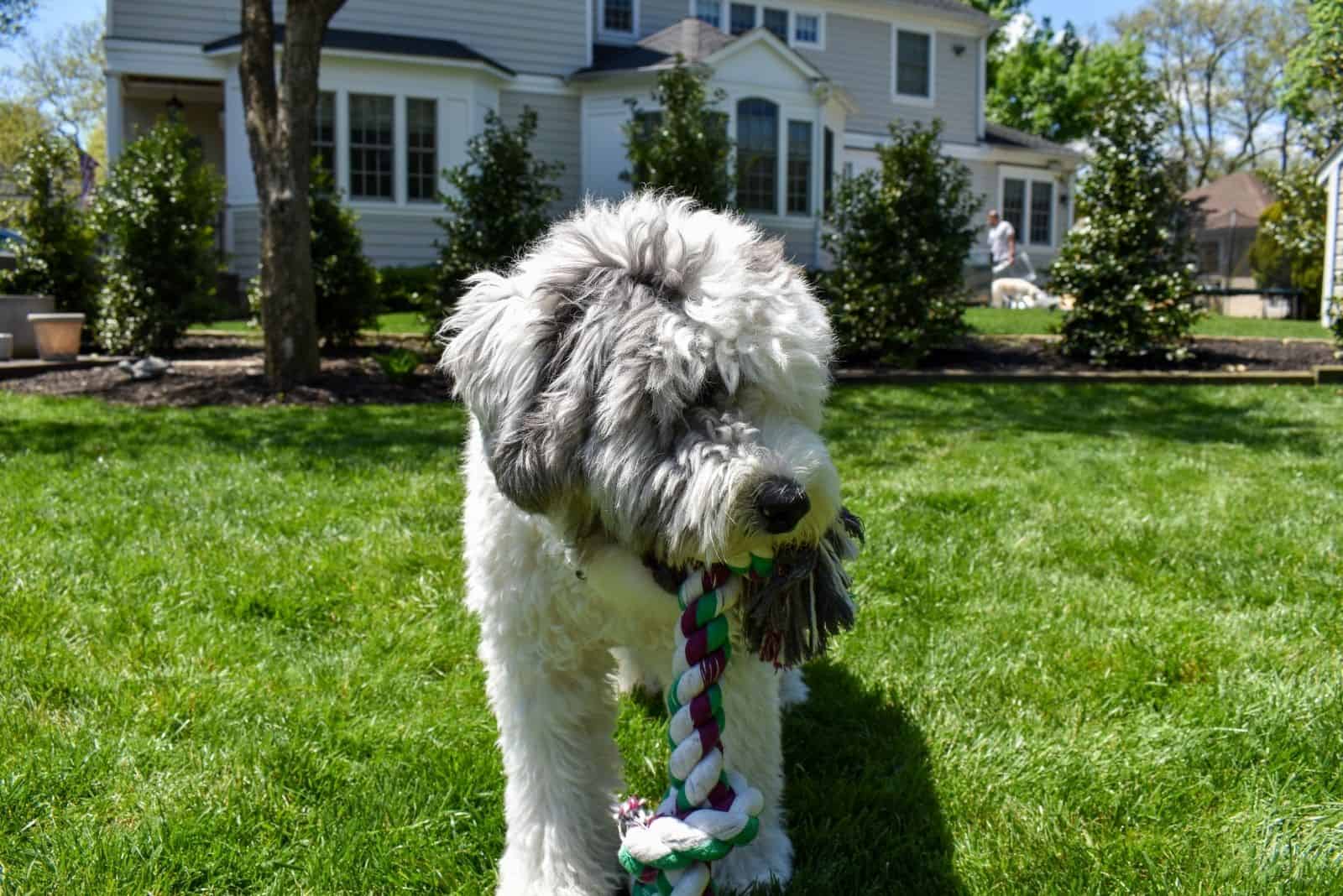
The OES has a lifespan of between ten and twelve years, while the Poodle is slightly more at twelve to fifteen years.
When you put them together, this OES Poodle mix has a life expectancy that matches the Poodle. Considering that this covers all three sizes (toy, mini, and standard), that’s pretty good, as big dogs usually have a shorter lifespan than small ones.
However, it’s generally believed that the two smaller versions outlive the standard-size dog by a year or two. Even so, Standard Sheepadoodles have been known to live up to 15 years of age.
It’s difficult to get accurate figures as organizations like the American Kennel Club don’t recognize designer dogs, so they can’t be registered.
However, we can be reasonably confident that, whatever its size, your Doodle is likely to live for at least twelve years and possibly up to fifteen years.
Can You Be Allergic To A Sheepadoodle?
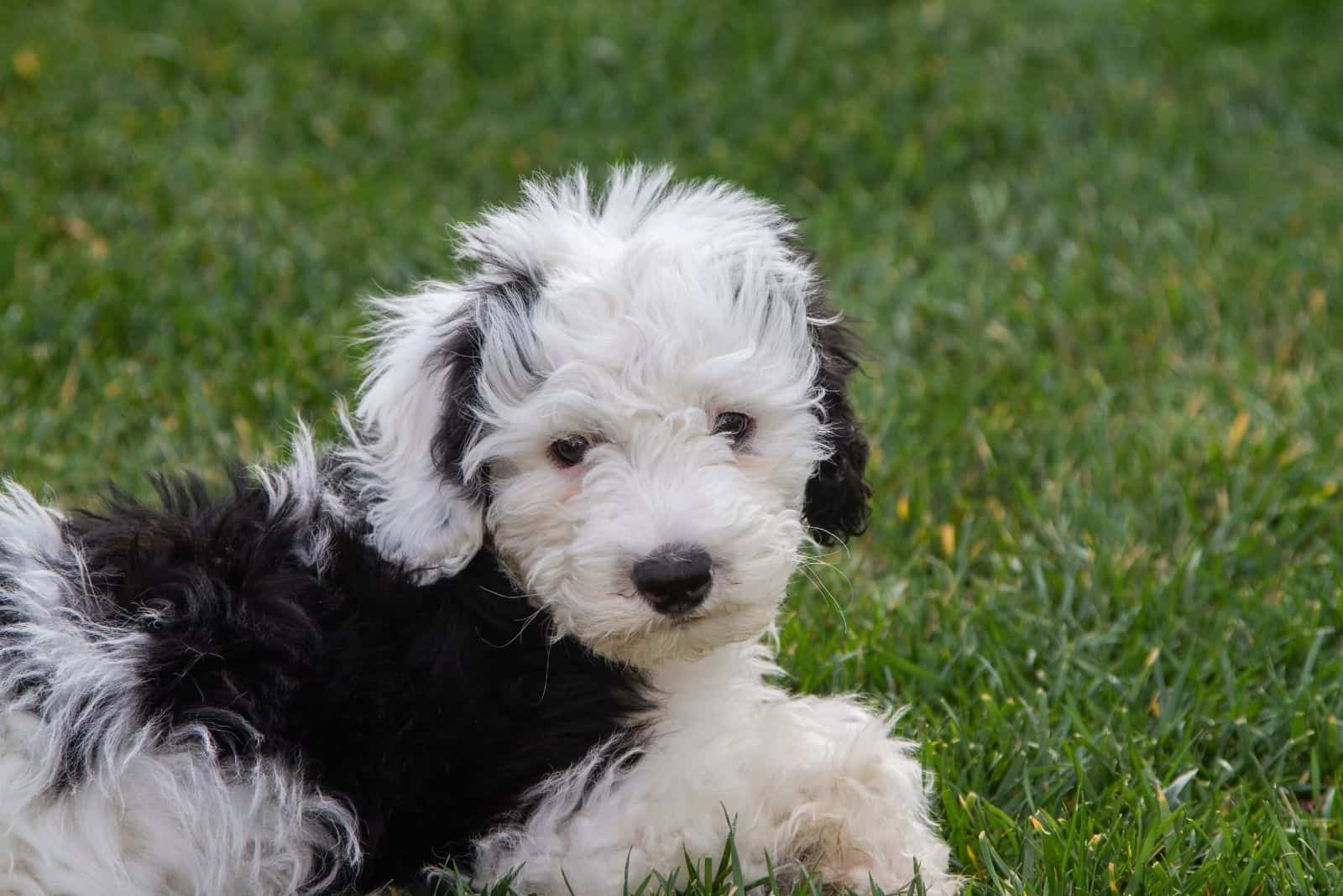
Yes, you can.
If that’s confusing, it may be because you’ve been on websites or spoken to people who have no clue what hypoallergenic means.
You’ve seen sentences like, no breed is completely hypoallergenic, or our dogs are 100% hypoallergenic!
The best thing to do is forget what you’ve read or think you know. Phrases like these are unhelpful nonsense at best; at worst, they’re misleading and fraudulent! Any breeder who claims their dogs are entirely allergy-free should be avoided.
The term hypoallergenic simply means that the dog is less likely than some other breeds to trigger your allergy. It does not mean allergy-free! This makes the phrase no dog breed is completely hypoallergenic sound pretty daft.
Whether you have an allergic reaction or not depends on the individual dog and the severity of your allergy.
The trouble is, these things are difficult to measure. Each person is unique and reacts differently to specific allergens. And although a dog breed can be listed as allergy-friendly, it’s a general guide only.
So, a dog can’t ever be considered 100% allergy-free as there will always be the possibility that someone may have an allergic reaction to them.
Also, as we saw above, some Sheepadoodles inherit the longer OES coat instead of the curly Poodle coat. This means that they may shed more hair and possibly spread more dander.
Are Sheepadoodles hypoallergenic? Mostly, but it doesn’t mean they are allergy-free.
Do Sheepadoodles Shed?
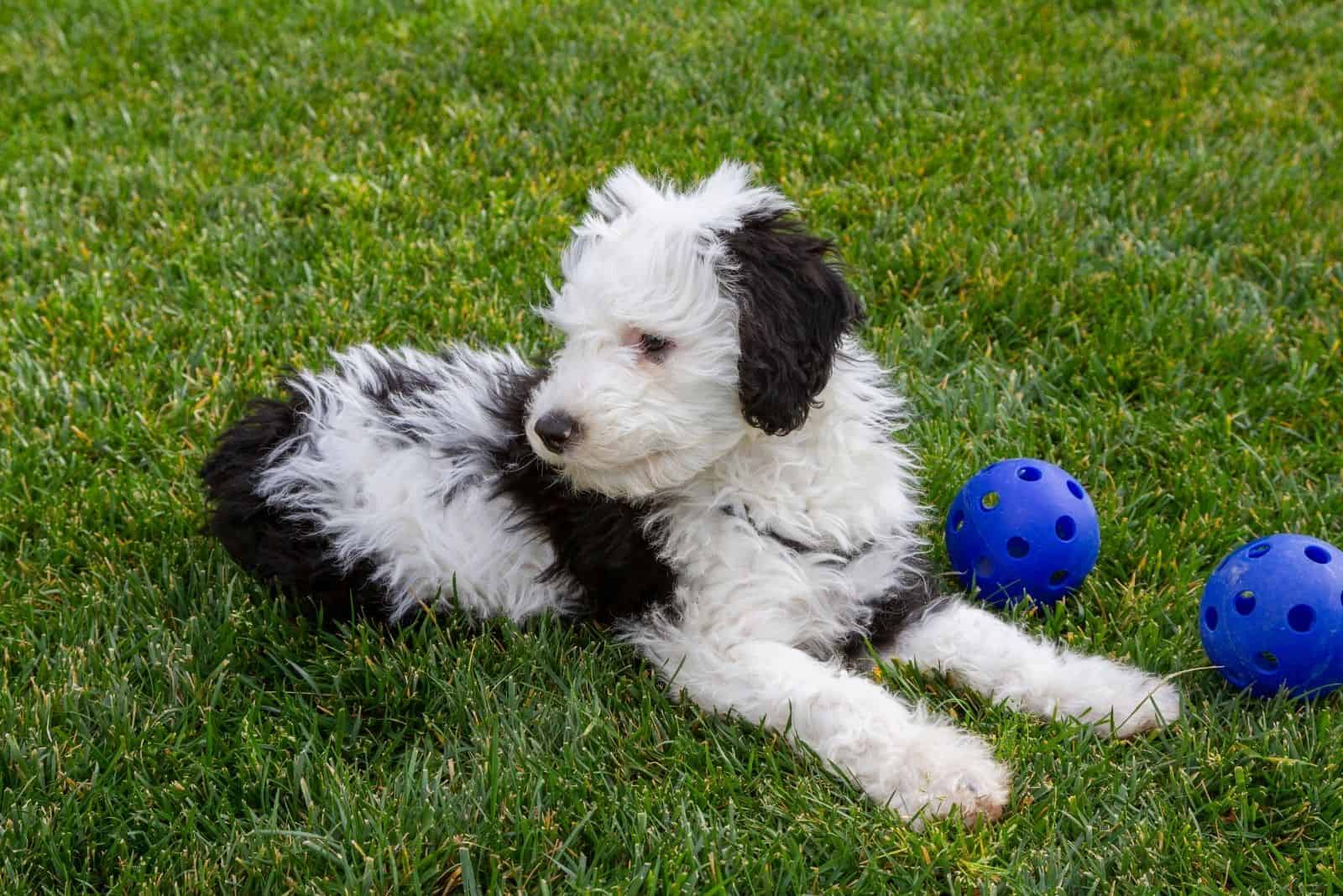
Yes, but they are low-shedding dogs. Shedding can be a real pain, as dog hair gets everywhere – on clothes, furniture, bedding, and even in your food.
Many dog lovers accept this as part of sharing your home with a canine companion, while others find it annoying. If you’re particularly houseproud, you really don’t want hair all over your furniture and clothes!
The Old English Sheepdog (OES) is a moderate to heavy shedder, which is one of the reasons why breeders decided to create a designer dog using this breed. As well as providing a low-shedding coat, it also aimed to avoid some of the health issues faced by the OES.
So, although the Sheepadoodle does shed a bit, its coat mostly just grows. And it keeps on growing, meaning that you’ll have to trim it pretty regularly. There are several adorable cuts that you can try if you feel confident enough, or you can get a professional groomer to do it for you.
Keeping the coat trimmed this way looks great, but it’s also a practical way of controlling the length, which keeps the coat healthy.
Are Sheepadoodles hypoallergenic? Yes, most are, but it isn’t only about shedding!
What Causes Pet Allergies?
It’s all to do with your immune system. Most of the time, it’s doing a brilliant job, keeping out all those nasties that are attacking your body day in and day out.
It fights pathogens like viruses, bacteria, parasites, fungi, and even cancer cells. The immune system seeks out harmful substances in the body and neutralizes them. All in all, it does a fantastic job!
However, it works a little too well in some cases.
Dogs produce proteins (called Can f1) that are present in their saliva, dander, urine, and feces. Dander (tiny flakes of dry skin) falls off the dog when it scratches or rubs against things, and this floats around your home.
Dander also sticks to loose dog hair, which attaches to your furniture, clothes, and carpets. Dogs lick themselves, and the saliva dries on the hair. And as dogs clean themselves with their tongue, Can f1 from feces and urine also gets onto the dog’s coat.
Inevitably, dog owners come into contact with these proteins. When they touch your skin or enter the eyes, nose, mouth, or ears, your immune system detects them and decides how to react.
In most people, the immune system can tell that these are harmless (if a little unpleasant), and it doesn’t react. However, for allergy sufferers, it’s a different story.
The immune system identifies these allergens as potentially harmful invaders and goes into overdrive! Now, it’s important to remember that this is not the dog’s fault: it’s not the protein Can f1 that causes your skin to break out into hives.
It isn’t the allergen that brings on a sneezing fit or makes your eyes red, swollen, and itchy. All of this is down to a natural hormone called histamine that floods the body to drive out what it believes to be a foreign invader!
These reactions are designed to stop the protein from damaging the cells or infecting the body with disease. And it’s all completely unnecessary.
Now we know what causes it, let’s look at how a dog can be hypoallergenic.
What Is An F1 Sheepadoodle?
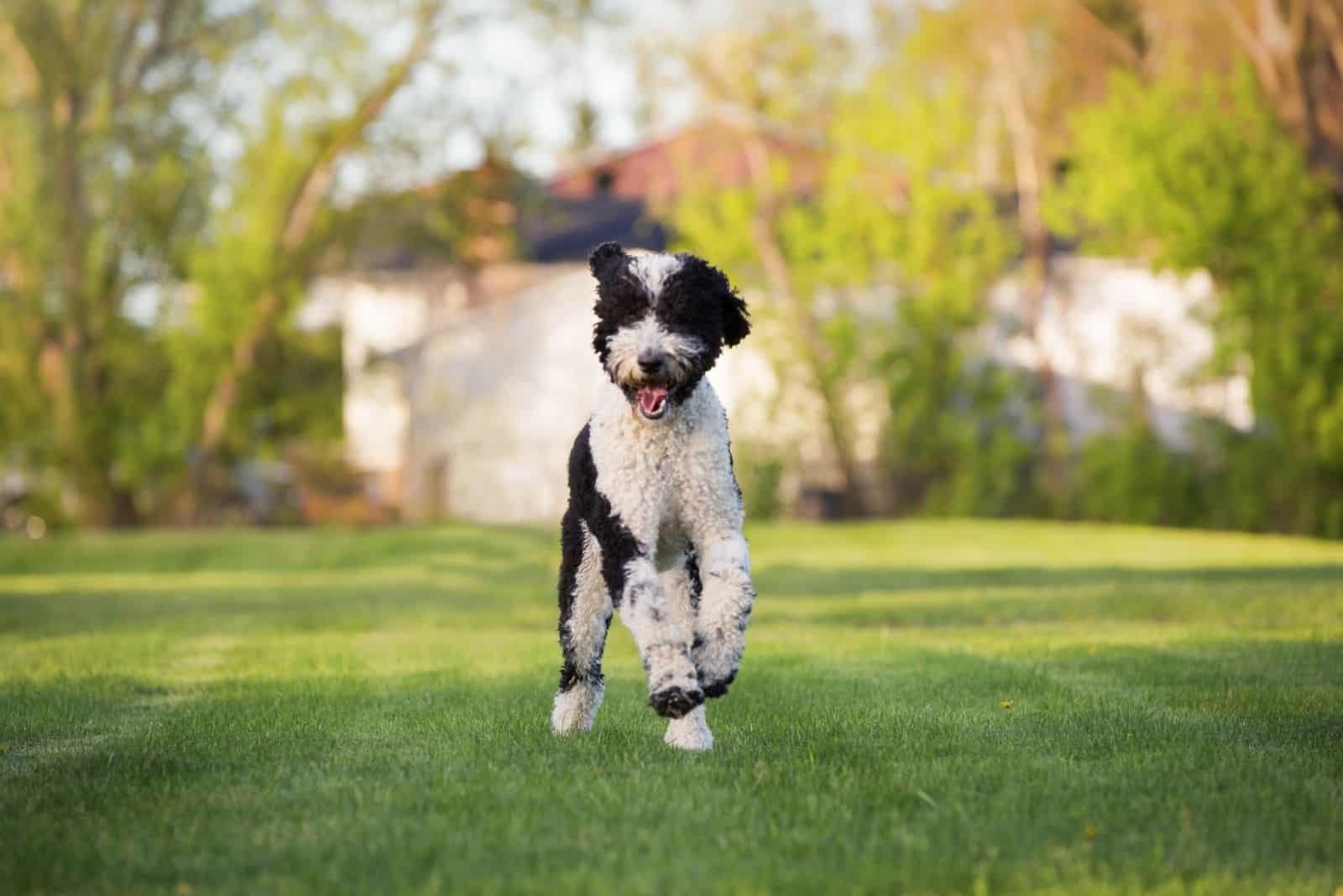
First off, it’s got nothing to do with the Can f1 protein we talked about earlier! This is a code that breeders use to identify a pup as first generation.
So, an F1 Sheepadoodle is a 50:50 mix of the purebred Poodle and OES.
A breeder might then choose to mix an F1 Sheepadoodle with a purebred OES, producing an F1b Sheepadoodle, which is 75% Poodle and 25% Old English Sheepdog.
F1b dogs are almost sure to have the Poodle coat and are therefore considered the best dog for households with allergy sufferers.
Some breeders go on to produce second-generation dogs, or F2 Sheepadoodles, which are a mix of two F1s!
This can get confusing, so we’ll leave it here except to say that the ‘b’ in F1b means ‘backcrossed,’ and the number refers to the generation. Back-crossing is a way of saying that one of the original pure breeds was used in the mix.
What Is A Hypoallergenic Dog?
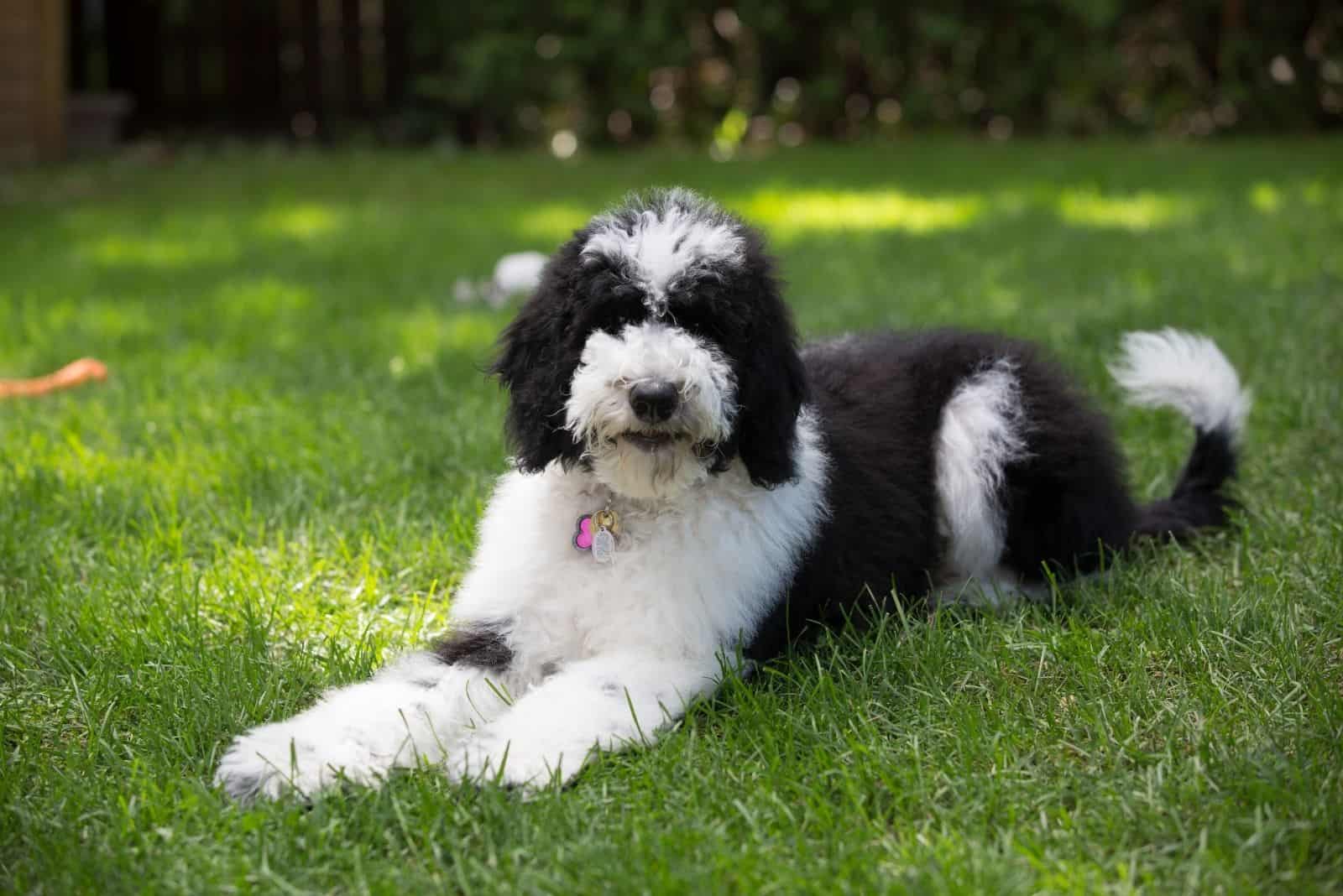
We’ve seen what distress and bother allergies can cause, so it’s no surprise that people are searching for allergy-friendly dogs!
But what does it mean?
Let’s look at the Sheepadoodle for a moment to find the answer:
• It’s a low-shedding breed. All dogs shed, to some extent, even ‘hairless’ breeds. Some breeders sell dogs as ‘non-shedding,’ which is misleading. However, those that don’t shed as much are generally better for allergy sufferers as there won’t be as much dander.
• It doesn’t produce as much dander. This stuff is public enemy #1 for allergy sufferers! Dogs that have bad skin will often make more of this flaky skin. It’s so light that it floats around like dust. Sheepadoodles don’t produce much at all, so they are more allergy-friendly.
• It has a wavy/curly coat. On top of being low-shedding, their coats are wavy and curly, a little like the Poodle’s coat. Any loose hairs become trapped in the curls, stopping them from falling out around the home.
• It doesn’t lick its coat constantly. Some dogs feel the need to wash all the time, so they’re always licking their fur. The Sheepadoodle doesn’t do this as they are naturally clean.
All of these traits reduce the risk of allergens spreading around your home, so you are less likely to experience an allergic reaction.
However, it’s essential to understand that you still may have a reaction, just as some humans get a rash from hypoallergenic band-aids!
As we learned earlier, it’s all to do with the human immune system.
Are Mini Sheepadoodles Hypoallergenic?
Yes, they are if they inherit the wavy coat.
Mini Sheepadoodles are an excellent choice as they’re neither too big nor too small. You avoid the issue of coping with a large dog in your home, particularly if space is limited. You also don’t have the worry of health problems associated with smaller breeds.
And as we mentioned earlier, small dogs are a better choice for people with allergies as they won’t produce as much dander as bigger dogs.
Mini Sheepadoodles share the same qualities as their bigger counterparts: they’re goofy, endlessly playful and fun-loving, deeply affectionate, and very energetic!
Advice For Pet Allergy Sufferers
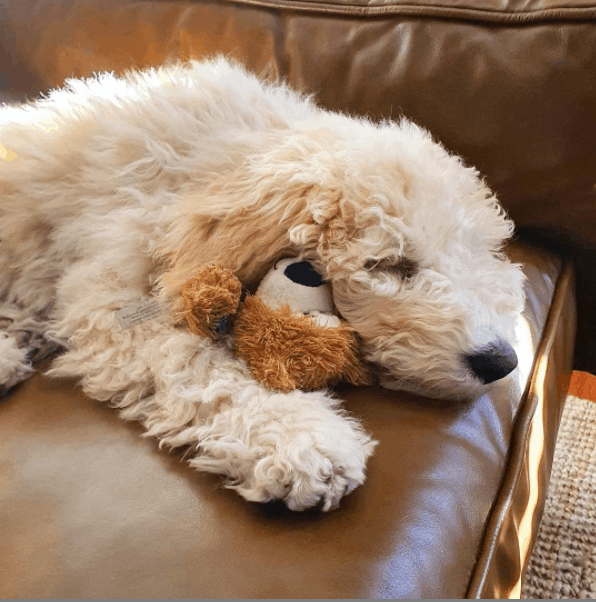
So, you suffer from allergies, but you want the joy of sharing your home and life with a cuddly pooch? Getting a Sheepadoodle is a step in the right direction, but there are several ways to reduce the risk of those pesky allergens getting into your system even further.
Allergies are a problem for between 40 and 60 million Americans, and many of these are pet owners. Whether you have an allergy-friendly dog or not, here are some tips to help you out:
• Buy a decent vacuum cleaner. Your old one may be great and perform perfectly well. But if it doesn’t have a HEPA filter (High-Efficiency Particulate Air filter), then you’re simply moving dust and dander around!
• Change your flooring. Admittedly, it’s a pretty drastic step and not practical for some people. However, if you can replace carpets and rugs with laminate flooring or a smooth, seamless surface, hair and dander won’t stick and can be vacuumed up easily.
• Brush your dog frequently. This should be part of your grooming routine anyway. Although they have a single coat, Sheepadoodles need a lot of maintenance to stop their coat matting. Regular brushing removes the loose hair trapped in the coat (it’s best to brush your dog outdoors if possible).
• Trim your dog’s coat. Regular trimming keeps the coat healthy and under control. If you don’t feel confident doing this, book a session with a professional groomer.
• Bathe your dog regularly. Bathing your dog every one or two months keeps their skin clean and healthy. Don’t do this too often, though, as it can have the opposite effect! Your dog’s skin will dry out, becoming itchy and flaky, which will produce more dander. Only use dog shampoos and conditioners. If you find that you need to wash your dog more frequently, only use clear, warm water.
• Wash your hands after petting your puppy to eliminate the allergens that cause a reaction.
• Wash your pet’s bedding. Dog beds can become coated in loose hair and dead skin cells. Aside from cleaning away allergens, washing your dog’s bed (and blankets) will keep them smelling fresh.
• Keep pets out of the bedroom. It’s good to have a space where your dog doesn’t go, and the bedroom is an excellent choice as you spend a lot of time here. If you allow your dog in the bedroom or even on your bed, those Can f1 proteins will spread across your bedding and float in the air. These will eventually enter your nose or mouth, setting off your allergy.
• Keep a tidy house. Clutter gives hair and dander a place to hide. Tidying up and cleaning regularly cuts down dust, pollen, dander, hair, and anything else that might contribute to your allergy.
• Get a good-quality air filter. Again, this should have a HEPA filter if it’s going to be of any use. Leave it running in a room for a few hours to clean allergens from the air. It’s also good to open up your windows to allow a through-draft when possible.
And now you’re good to go! Using these tips, you can reduce the misery that allergies cause. Of course, it’s best to consult a medical professional about your allergy. We can only offer general advice, and this can never take the place of medical advice from a trained professional.
Your family doctor may prescribe antihistamines to help you manage your condition, but it’s fair to say that these are sometimes ineffective.
You’re the only one who knows how bad your allergy is (or how bad a family member suffers), so it’s up to you to weigh up the pros and cons of getting a dog. An allergy-friendly breed could be the answer, and now you have some other tips to guide you.
What Is The Most Hypoallergenic Dog?
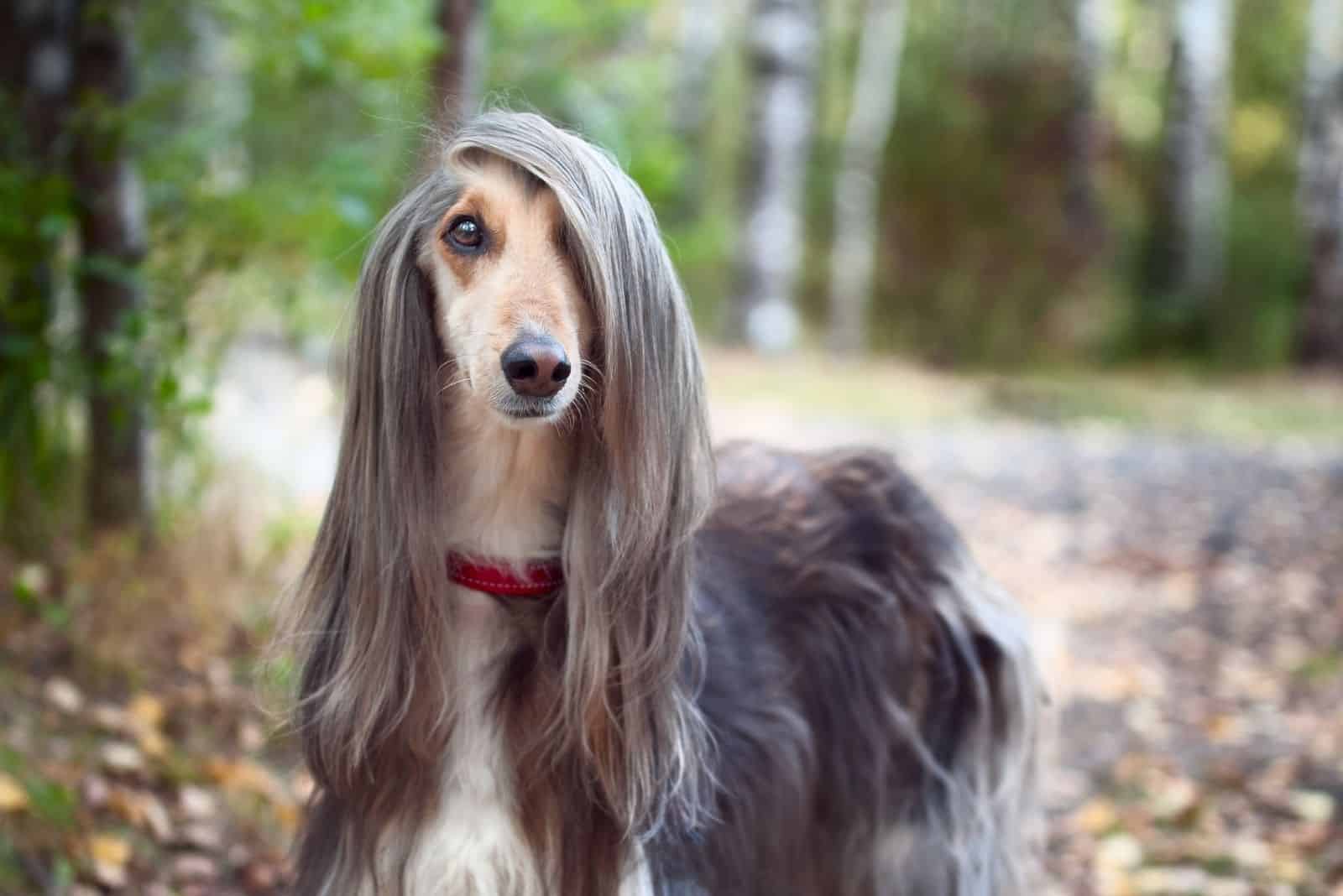
Well, you can’t have a ‘most hypoallergenic’ anything for a start! It’s either hypoallergenic, or it isn’t. That is, it’s either less likely to provoke an allergic reaction, or it isn’t.
It’s impossible to measure this!
Even so, the Poodle is probably considered the number one allergy-friendly dog, which is why it has been bred with so many other dogs to create wonderful mixed breeds like the Goldendoodle, Labradoodle, and the Sheepadoodle.
Despite the Poodle’s position at the top, there are other breeds to consider, aside from all the ‘Doodle dogs.’
If you want to learn more, check out these hypoallergenic breeds:
• Basenji
• Afghan Hound
• Schnauzer (miniature, standard, and giant breeds)
• Maltese
• American Hairless Terrier
• Bichon Frise
• Irish Water Spaniel
• Peruvian Inca Orchid
• Havanese
• Komondor
• Mexican Hairless Dog (Xoloitzcuintle)
• Puli
• Lhasa Apso
• Yorkshire Terrier
• Shih Tzu
• Affenpinscher
• Bedlington Terrier
• Chinese Crested
• Portuguese Water Dog
• Lagotto Romagnolo
• Coton de Tulear
• Kerry Blue Terrier
The list goes on! However, there’s more than enough choice for anyone right here, and we can almost guarantee that most people won’t be familiar with many of these names.
It’s worth checking them out as each has its unique qualities aside from being allergy-friendly.
Conclusion: Are Sheepadoodles Hypoallergenic?
The primary aim of this guide was to answer the question, Are Sheepadoodles hypoallergenic?
As we discovered right from the start, the answer is yes, although, in fairness, it perhaps should be probably.
Confusion and misunderstanding will probably still cloud the issue, but you now have the facts. You know that hypoallergenic dogs do exist, but it doesn’t mean they are completely allergy-free! You also now know that the phrase ‘100% hypoallergenic’ is nonsense.
It all comes down to the severity of your allergy and the quantity of allergens the individual dog produces.
A Sheepadoodle with a wavy coat will shed much less than many other breeds and produce less dander, therefore is much less likely to trigger an allergic reaction. This is the very definition of hypoallergenic!
It isn’t more hypoallergenic or less hypoallergenic, as this quality can’t be measured. It is simply hypoallergenic.
On our quest for the truth, we also discovered more about the amazing Sheepadoodle. As well as being allergy-friendly, they make excellent family pets. They’re affectionate and loving, great with all family members, including young children, and good around other dogs.
You really couldn’t ask for any more in a dog!
The two main sticking points are that these dogs can be stubborn at times and have a lot of energy to use up. It’s not that they’re aggressive or bad-tempered at all, far from it! But they might decide to do their own thing once in a while.
The best way to cope with this is through obedience training, starting at a very early age.
As for their energy levels, you’ll have to make sure they have an outlet for them. On top of their daily exercise routine, including walks and playtime, you could sign them up for doggy sports.
Once you’ve got that sorted, life with your allergy-friendly dog will be happy, healthy, and fun!
Read Next: 10 Mini Sheepadoodle Breeders In Whom You Can Trust
